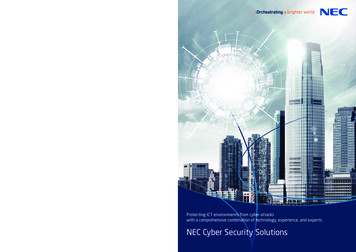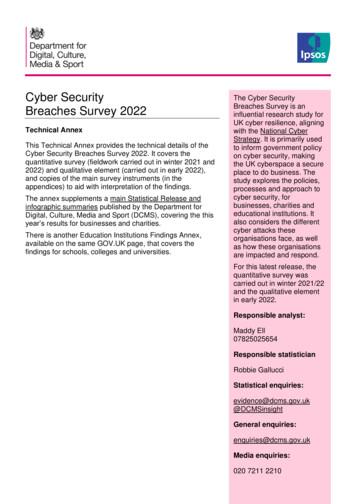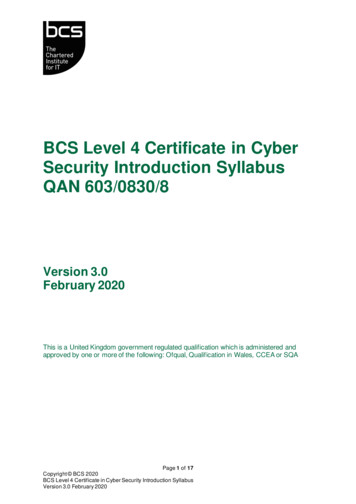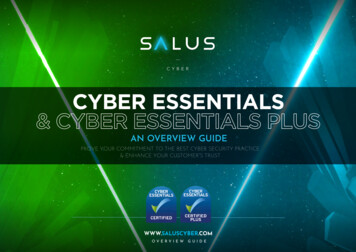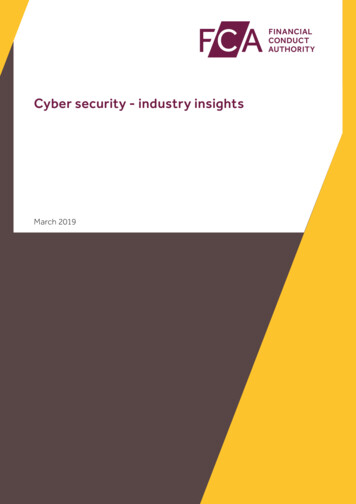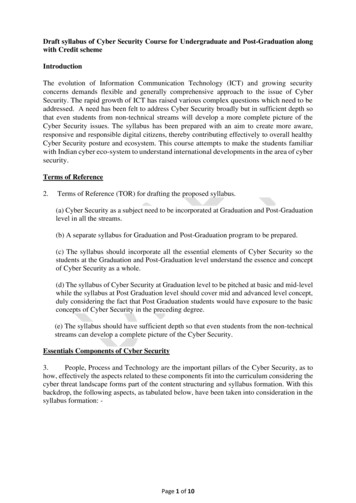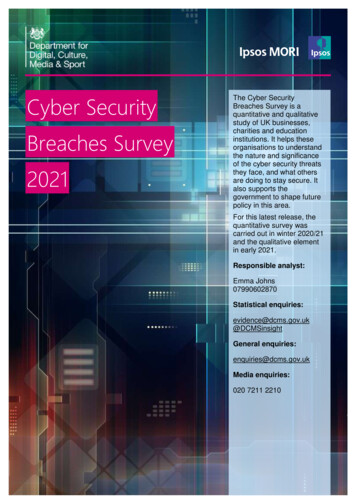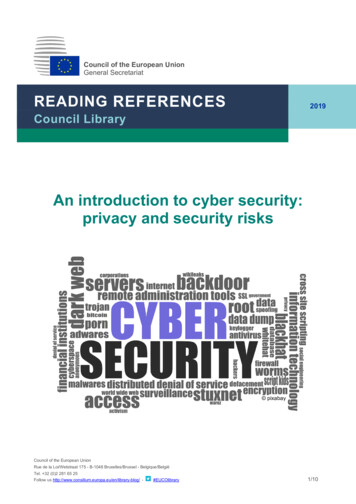
Transcription
Council of the European UnionGeneral SecretariatREADING REFERENCES2019Council LibraryAn introduction to cyber security:privacy and security risks pixabayCouncil of the European UnionRue de la Loi/Wetstraat 175 - B-1048 Bruxelles/Brussel - Belgique/BelgiëTel. 32 (0)2 281 65 25Follow us http://www.consilium.europa.eu/en/library-blog/ -#EUCOlibrary1/10
IntroductionCyber security is becoming a more crucial topic in both policy making and the every-daylife of EU citizens. With October being the European Cyber Security month, as well theFinnish Presidency priority on hybrid and cyber threats, the Council Library has compiled areading relating to personal cyber security as well as the importance of a strong nationaland international cyber security infrastructure. It contains numerous books and articles thatyou can access via Eureka.Resources selected by the Council LibrariesPlease note:This bibliography is not exhaustive; it provides a selection of resources made bythe Council Library. Most of the titles are hyperlinked to Eureka, the resourcediscovery service of the Council Library, where you can find additional materials onthe subject. Access to some resources might be limited to registered CouncilLibrary users or to users in subscribing institutions.The contents are the sole responsibility of their authors. Resources linked from thisbibliography do not necessarily represent the positions, policies, or opinions of theCouncil of the European Union or the European Council.Reuse of the covers is prohibited, they belong to the respective copyrightholders.Additional resources may be added to this list by request - please contact theCouncil Library to suggest a title: library@consilium.europa.euCouncil of the European UnionRue de la Loi/Wetstraat 175 - B-1048 Bruxelles/Brussel - Belgique/BelgiëTel. 32 (0)2 281 65 25Follow us http://www.consilium.europa.eu/en/library-blog/ -#EUCOlibrary2/10
BooksCybersecurity : the beginner's guide : a comprehensiveguide to getting started in cybersecurityErdal OzkayaBirmingham : Packt , 2019Request via Eureka"This book explores the need for cyber security and what individualscan do to fill the cybersecurity talent gap. Additionally, it also looks atsecurity domain changes and how artificial intelligence and machine learning are helping to securesystems. It examines the skills and tools that everyone who wants to work as security personalneed to be aware of, as well as how to think like an attacker and explore some advanced securitymethodologies."The basics of cyber safety : computer and mobile devicesafety made easyJohn Sammons ; Michael CrossAmsterdam, Netherlands : Elsevier , 2017Request via Eureka"The book presents modern tactics on how to secure computer andmobile devices, including what behaviours are safe while surfing,searching, and interacting with others in the virtual world. The book is for readers who know verylittle about the basic principles of keeping the devices they are connected to―orthemselves―secure while online. In addition, the text discusses, in a non-technical way, the costof connectedness to your privacy, and what you can do to it, including how to avoid all kinds ofviruses, malware, cybercrime, and identity theft. Final sections provide the latest information onsafe computing in the workplace and at school, and give parents steps they can take to keepyoung kids and teens safe online."Council of the European UnionRue de la Loi/Wetstraat 175 - B-1048 Bruxelles/Brussel - Belgique/BelgiëTel. 32 (0)2 281 65 25Follow us http://www.consilium.europa.eu/en/library-blog/ -#EUCOlibrary3/10
Digital privacy and security : using Windows a practicalguideNihad Hassan ; Rami Hijazi (Eds.)Berkeley, CA : Apress : Imprint: Apress , 2017Request via Eureka"Use this hands-on guide to understand the ever growing and complexworld of digital security. Learn how to protect yourself from digital crime,secure your communications, and become anonymous online usingsophisticated yet practical tools and techniques. This book teaches youhow to secure your online identity and personal devices, encrypt your digital data and onlinecommunications, protect cloud data and Internet of Things (IoT), mitigate social engineeringattacks, keep your purchases secret, and conceal your digital footprint. You will understand bestpractices to harden your operating system and delete digital traces using the most widely usedoperating system, Windows."Cybersecurity essentialsCharles J. Brooks ; Philip Craig ; Donald ShortSomerset : John Wiley & Sons , 2018Access via Eureka"Cybersecurity Essentials provides a comprehensive introduction tothe field, with expert coverage of essential topics required for entrylevel cybersecurity certifications. An effective defense consists of fourdistinct challenges: securing the infrastructure, securing devices, securing local networks, andsecuring the perimeter. Overcoming these challenges requires a detailed understanding of theconcepts and practices within each realm. This book provides the foundational information youneed to understand the basics of the field, identify your place within it, and start down the securitycertification path. Each part concludes with a summary of key concepts, review questions, andhands-on exercises, allowing you to test your understanding while exercising your new criticalskills"Council of the European UnionRue de la Loi/Wetstraat 175 - B-1048 Bruxelles/Brussel - Belgique/BelgiëTel. 32 (0)2 281 65 25Follow us http://www.consilium.europa.eu/en/library-blog/ -#EUCOlibrary4/10
Understanding security issuesScott E. Donaldson ; Chris K. Williams ; Stanley G. SiegelBoston : Walter de Gruyter Incorporated , 2019Request via Eureka"With the threats that affect every computer, phone or other deviceconnected to the internet, security has become a responsibility not justfor law enforcement authorities or business leaders, but for everyindividual. Your family, information, property, and business must beprotected from cybercriminals in the office, at home, on travel, and inthe cloud. Understanding Security Issues provides a solid understanding of the threats, andfocuses on useful tips and practices for protecting yourself, all the time, everywhere and anywhereyou go.This book discusses security awareness issues and how you can take steps to reducethe risk of becoming a victim: The threats that face every individual and business, all the time.Specific indicators of threats so that you understand when you might be attacked and what to do ifthey occur."Cybersecurity : protecting your identity and dataMary-Lane KambergNew York, New York : Rosen Central , 2018Request via Eureka"This book introduces readers to the importance of cybersecurity andaddresses the current risks from hackers, viruses and other malware,identity thieves, and other online perils. It provides concretemeasures that young digital natives can take to protect themselves and their computers,smartphones, and other devices. This volume's lively, cautionary narrative and useful tips will helpreaders effectively defend their identities and data."Council of the European UnionRue de la Loi/Wetstraat 175 - B-1048 Bruxelles/Brussel - Belgique/BelgiëTel. 32 (0)2 281 65 25Follow us http://www.consilium.europa.eu/en/library-blog/ -#EUCOlibrary5/10
Personal cybersecurity: how to avoid and recover fromcybercrimeMarvin WaschkeBerkeley, CA : Apress : Imprint: Apress , 2017Request via Eureka"This book covers personal cybersecurity for all modes of personalcomputing whether on consumer-acquired or company-issued devices:desktop PCs, laptops, mobile devices, smart TVs, WiFi and Bluetooth peripherals, and IoT objectsembedded with network-connected sensors. In all these modes, the frequency, intensity, andsophistication of cyberattacks that put individual users at risk are increasing in step withaccelerating mutation rates of malware and cybercriminal delivery systems. Through instructiveexamples and scenarios, the author shows you how to adapt and apply best practices to your ownparticular circumstances, how to automate and routinize your personal cybersecurity, how torecognize security breaches and act swiftly to seal them, and how to recover losses and restorefunctionality when attacks succeed."Hacken für dummiesKevin M. Beaver (author) ; Gerhard Franken (translator)Weinheim : Wiley , 2018Request via Eureka"Der beste Weg, den eigenen Computer vor Hack-Angriffen zuschützen, ist zu wissen, wie Hacker arbeiten. Betrachten Sie IhrenComputer oder Ihr Computersystem vom Standpunkt eines ,welcheSchwachstellen Netzwerke haben, wie die Betriebssysteme Windows, Linux und MacOS Xangreifbar sind und wie Datenbanken ausspioniert werden können. Der Autor zeigt Ihnen, wie SieIhre Systeme auf Schwachstellen überprüfen und Sicherheitslücken ausbessern können. MachenSie sich die Tricks der Hacker zu eigen und drehen Sie den Spieß um."Council of the European UnionRue de la Loi/Wetstraat 175 - B-1048 Bruxelles/Brussel - Belgique/BelgiëTel. 32 (0)2 281 65 25Follow us http://www.consilium.europa.eu/en/library-blog/ -#EUCOlibrary6/10
Cyber smart : five habits to protect your family, money, andidentity from cyber criminalsBart McDonoughIndianapolis, IN : Wiley , 2019Request via Eureka"The rise of new technologies in our lives, which has taken us frompowerful mobile phones to fitness trackers and smart appliances inunder a decade, has also raised the need for everyone who uses theseto protect themselves from cyber scams and hackers. Every new device and online service youuse that improves your life also opens new doors for attackers looking to discover your passwords,banking accounts, personal photos, and anything else you want to keep secret. In Cyber Smart,author Bart McDonough uses his extensive cybersecurity experience speaking at conferences forthe FBI, major financial institutions, and other clients to answer the most common question hehears: "How can I protect myself at home, on a personal level, away from the office?"Caught on the web : the ultimate cybersecurity guideJonathan Reuvid (Ed.)London : Legend Business , 2018Request via Eureka"From passwords to opening emails, everyone knows what they shoulddo but do you do it? Tons of malicious content floods the internet whichcan compromise your system and your device, be it your laptop, tabletor phone. How often do you make payments online? Do you havechildren and want to ensure they stay safe online? How often do you sitat a coffee shop and log onto their free WIFI? This book will guide you and provide solutions toavoid common mistakes and to combat cyber-attacks. This Guide covers areas such as: Buildingresilience into our IT Lifestyle Online Identity Cyber Abuse: Scenarios and Stories ProtectingDevices Download and share Gaming, gamble and travel Copycat websites I Spy and QR CodesBanking, apps and Passwords etc."Council of the European UnionRue de la Loi/Wetstraat 175 - B-1048 Bruxelles/Brussel - Belgique/BelgiëTel. 32 (0)2 281 65 25Follow us http://www.consilium.europa.eu/en/library-blog/ -#EUCOlibrary7/10
IoT-Hacking : Sicherheitslücken im Internet der Dingeerkennen und schliessenNitesh Dhanjani (author) ; René Schönfeldt ; Ursula Zimpfe (Eds.) ;Helmut Kraus (designer)Heidelberg, Germany : dpunkt.verlag , 2016Request via Eureka"In Zukunft werden Milliarden »Dinge« über das Internet uchgigantischeSicherheitsrisiken. In diesem Buch beschreibt der international renommierte IT-SicherheitsexperteNitesh Dhanjani, wie Geräte im Internet of Things von Angreifern missbraucht werden können –seien es drahtlose LED-Lampen, elektronische Türschlösser, Babyfone, Smart-TVs oder Autos mitInternetanbindung. Wenn Sie Anwendungen für Geräte entwickeln, die mit dem Internet verbundensind, dann unterstützt Dhanjani Sie mit diesem Leitfaden bei der Erkennung und Behebung vonSicherheitslücken. Er erklärt Ihnen nicht nur, wie Sie Schwachstellen in IoT-Systemenidentifizieren, sondern bietet Ihnen auch einen umfassenden Einblick in die Taktiken derAngreifer."Cybersecurity and cyberwar : what everyone needs to knowP.W Singer ; Allan FriedmanNew York : Oxford University Press , 2014Available at Legal Library Main Collection (SJUR INF 100591)"A generation ago, "cyberspace" was just a term from science fiction,used to describe the nascent network of computers linking a fewuniversity labs. Today, our entire modern way of life, fromcommunication to commerce to conflict, fundamentally depends on theInternet. We face new questions in everything from our rights andresponsibilities as citizens of both the online and real world to simply how to protect ourselves andour families from a new type of danger. And, yet there is perhaps no issue that has grown soimportant, so quickly, and that touches so many, that remains so poorly understood. The book isstructured around the key question areas of cyberspace and its security: how it all works, why it allmatters, and what can we do? "Council of the European UnionRue de la Loi/Wetstraat 175 - B-1048 Bruxelles/Brussel - Belgique/BelgiëTel. 32 (0)2 281 65 25Follow us http://www.consilium.europa.eu/en/library-blog/ -#EUCOlibrary8/10
CybersecurityMelissa Higgins (author) ; M. G Higgins ; Joshua J. Pauli (contributors)Minneapolis, Minnesota : Essential Library, an imprint of AbdoPublishing , 2016Request via Eureka"Cybersecurity discusses the evolving nature of Internet-based attacks,the vulnerabilities of individuals and corporations to these threats, andthe hackers who carry out or defend against cyberattacks."Cybersecurity expertDaniel R. FaustNew York, NY : PowerKids Press , 2018Request via Eureka"With our use of technology increasing every day, it's not surprising thatour need for cybersecurity experts is also growing. In this informativetext, readers will learn about why we need cybersecurity and what thesesecurity experts do to keep sensitive digital information safe. Students are introduced to theconcept of computational thinking, as well as STEM concepts addressed in the Next GenerationScience Standards. Informational diagrams and full-color photographs help students makeconnections with the text."Council of the European UnionRue de la Loi/Wetstraat 175 - B-1048 Bruxelles/Brussel - Belgique/BelgiëTel. 32 (0)2 281 65 25Follow us http://www.consilium.europa.eu/en/library-blog/ -#EUCOlibrary9/10
What is cybersecurity?Haq KamarNew York : Britannica Educational Publishing in association with RosenEducational Services , 2017Request via Eureka"Inexperienced users of computers often jump at the chance to clickcolorful flashing ads on the sidebar and are also tempted to downloadfiles from sites not worthy of trust. In short, people need to learn how to stay safe online. This bookwill introduce readers to different types of online threats, including viruses and malware. They willlearn how different dangers spread and some basic steps to stop or prevent them. Additionally, thisbook will illuminate the scary consequences of falling prey to those threats, such as havingpersonal information stolen or deleted, and cyberstalking."Älypuhelimiin kohdistuvat kyberuhkat ja niiltä suojautuminenOtto LaitinenUniversity of Jyväskylä informaatioteknologian tiedekunta, 2019Abstract in English: "Smartphones are constantly evolving, and the number of the users isincreasing. However, the high number of the smartphone users has attracted a significant amountof cybercrime to the industry. This paper seeks to answer two research questions, what kind ofcyber threats fall on smartphones and how can cyber threats to smartphones be defended? Thestudy revealed that the number of cyber threats to smartphones has been steadily increasing andtheir efficiency has improved over the last few years. The most popular cyber threat tosmartphones is a malicious program called Trojan. The paper states that the most effective andsimple way to protect against cyber threats is to use as complicate security code as possible andinstalling the system updates right away after they are released."Council of the European UnionRue de la Loi/Wetstraat 175 - B-1048 Bruxelles/Brussel - Belgique/BelgiëTel. 32 (0)2 281 65 25Follow us http://www.consilium.europa.eu/en/library-blog/ -#EUCOlibrary10/10
"Cybersecurity Essentials provides a comprehensive introduction to the field, with expert coverage of essential topics required for entry-level cybersecurity certifications. An effective defense consists of four distinct challenges: securing the infrastructure, securing devices, securing local networks, and securing the perimeter.



